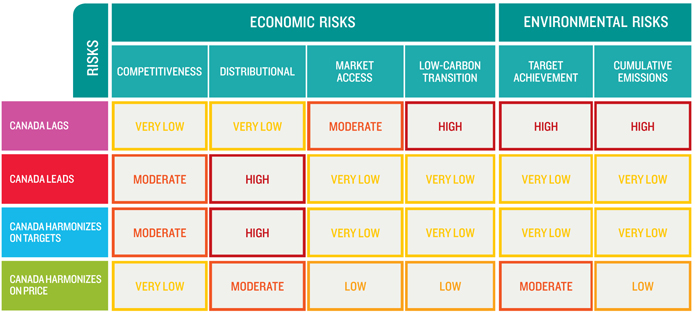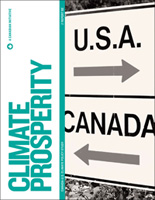Parallel Paths: Canada-U.S. Climate Policy Choices – Advise
Harmonization, where possible and when feasible, makes sense for Canada. The NRT offers a transitional climate policy option for decision makers to consider. It reduces emissions here in Canada while maintaining our competitiveness, and results in more investment in needed low-carbon innovation for the future. Parallel Paths – Together but different – allows Canada to harmonize climate policy with the United States while meeting our national needs and goals.

Executive Summary
A central question in Canadian climate policy remains, “What of the United States?”
Uncertainty about American climate policy colours and shapes Canada’s own policy choices and direction. By necessity, our integrated economies require serious consideration of harmonizing Canadian climate policy with that of the United States. But different energy economies and greenhouse gas emission profiles in the two countries create different economic and environmental implications for Canada as we pursue a harmonized policy approach. Understanding what these implications mean for Canada and how we implement our own climate policy is critical for Canada’s own prosperity.
Thinking strategically about how best to harmonize Canadian climate policy with that of the U.S. allows us to design a system that manages competitive risks, achieves real emission reductions, and drives the development of new clean energy and low-carbon technology. Challenges arise if the U.S. doesn’t move. What options exist for Canada? What steps can we take to achieve our own national environmental and economic goals given the integrated nature of our trading, investment and energy economies? [Read more]
THE CANADA-U.S. CLIMATE POLICY RISK MATRIX
Conclusions
The NRTEE’s original research and analysis in this report explores the economic and environmental implications for Canada of leading, lagging, and harmonizing with the U.S. on climate policy. Our analysis leads us to the following conclusions :
// HARMONIZING on carbon targets and harmonizing on carbon price have different consequences. Canada’s distinctive emissions profile and energy-economy structure mean that matching our GHG targets with those of the U.S. leads to higher carbon prices here. Alternatively, while matching carbon prices with those in the U.S. would reduce competitiveness concerns, fewer emission reductions would actually occur due to projected higher emissions growth in Canada than in the U.S. As a result, Canada would not meet its stated 2020 target.
// COMPETITIVENESS issues matter, but they matter most for about 10 % of Canada’s economy that is considered emissions-intensive and trade-exposed, including sectors such as oil and gas extraction, and cement manufacturing. Knowing this allows us to take mitigating actions that reduce the impact on those sectors and regions of the country through targeted policy measures.
// TRADE MEASURES in U.S. legislative proposals and low-carbon fuel standards do pose an economic risk for key Canadian sectors but these risks can likely be managed if Canada adopts equally stringent climate policy as the United States. Acting remains the best preventative measure.
// COSTS IMPOSED by Canada’s own climate policies and resulting emission reductions have the most impact on Canadian industry. It is not just costs from U.S. policy actions or from differences between Canadian and U.S. policies that matter. This means some costs will be present regardless of when Canada implements its full suite of climate policy actions.
[Read more]
Parallel Paths: Canada-U.S. Climate Policy Choices (full report)
Parallel Paths – Executive Summary
Parallel Paths – Outreach Report































